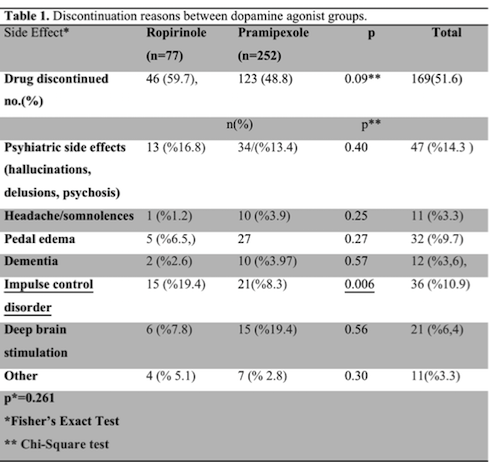Session Information
Date: Monday, September 23, 2019
Session Title: Neuropharmacology
Session Time: 1:45pm-3:15pm
Location: Les Muses Terrace, Level 3
Objective: To determine the incidence, causes and risk factors of dopamine agonists (pramipexole and ropinirole) discontinuation in Parkinson’s disease patients.
Background: Ropinirole and pramipexole are the most frequent preferred dopamine agonists (DA). Although these dopamine agonists are efficient and reliable in Parkison’s disease, the biggest challenge of using them in the therapy is their troubling side effects. In this study, pramipexole and ropinirole are examined for discontinuation reasons and risk factors.
Method: In this study 596 Parkinson’s disease patients’ data, followed in the Movement Disorders Center in Eskisehir Osmangazi University Department of Neurology between the years of 2008–2018, were included and reviewed retrospectively.
Results: Included were 329 Parkinson’s disease patients who treated with pramipexole and ropinirole (155- 47.1% of female/174-52.9% of male). The patients’ average age was 63,8±9,9 years, female/male ratio was 0,89, mean disease duration was 8,8±5,51 years, mean duration of treatment was 5,03±3,43 years and levodopa equivalent doses were 1006,46±507,89. The discontinuing ratio of dopamine agonists in all patients was 51,6% ± (169/329). Forty-six (59.7%) of the ropinirole group and 123 (48.8%) of the pramipexole group were discontinued DA therapy. There was no difference in age, gender, Hoehn&Yahr stages and duration of treatment between pramipexole and ropinirole groups. Discontinuing reasons and their comparisons were summarized in Table.1 [table 1 ]. In the ropinirole group, the rate of impulse control disorders (ICD) was significantly higher than pramipexole (p = 0.006). The patients using ropinirole was found to be 2.6 times more likely to have ICD than pramipexole (odds ratio = 2.66). The likelihood of ICD in men was 1.1 times higher in the total group and1.6 times higher in the ropinirole group by the female gender.
Conclusion: Treatment is terminated in more than half of the patients who started DA. Detecting the causes of drug discontinuation, being known to the physician and questioning during the examination will be useful for early recognition and treatment management.
To cite this abstract in AMA style:
N. Durmaz çelik, M. Kuzu Kumcu, S. Bostan, E. Yiğit Tekkanat, S. özkan. The Frequency, Causes and Risk Factors of Discontinuation of Dopamine Agonists in Parkinson’s Disease Patients [abstract]. Mov Disord. 2019; 34 (suppl 2). https://www.mdsabstracts.org/abstract/the-frequency-causes-and-risk-factors-of-discontinuation-of-dopamine-agonists-in-parkinsons-disease-patients/. Accessed November 8, 2025.« Back to 2019 International Congress
MDS Abstracts - https://www.mdsabstracts.org/abstract/the-frequency-causes-and-risk-factors-of-discontinuation-of-dopamine-agonists-in-parkinsons-disease-patients/

